Visual distortions
Visual distortions are defined as any subjective effect which alters and changes the perception or appearance of pre-existing visual data without adding any entirely new content.
This page lists and describes the various visual distortions which can occur under the influence of certain psychoactive compounds.
After images
After images (also known as palinopsia) are defined as visual perceptions which continue to appear in one's vision after exposure to the original image has ceased.[1][2][3] A common form of after image is the bright glow that seems to float in one's vision after looking into a light source for a few seconds. This effect is similar to tracers, but differs in that it does not create smooth blurs behind moving objects.
During hallucinogenic experiences, moving objects can produce a trail of overlayed, still images behind their path of motion.[2][4][5][6][7][8] This creates a series of overlayed images of a moving object across one's visual field which become more faded the longer the duration since the object occupied that location in space. Another common manifestation of this effect is being able to see a residual image of the external environment for several seconds after one closes their eyes before it gradually fades away.
After images are often accompanied by other coinciding effects such as tracers[5][9][10] and drifting.[4] They are most commonly induced under the influence of moderate dosages of psychedelic compounds, such as LSD, psilocybin, and mescaline.[11] However, trailing effects have also been experienced with other drugs of a very different pharmacology, such as GABA potentiators.[7]
Brightness alteration
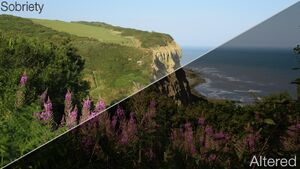
Brightness alteration is defined as a distortion or change in the levels of perceived brightness comprising a person's vision. This usually results in the person's vision becoming darker[1][5][12] and muted, but could also potentially result in it becoming lighter and more vivid[12][13] depending on the person's environment and substances they have consumed.
Brightness alteration can be accompanied by the coinciding effects of pupil dilation or constriction and photophobia. It is most commonly induced under the influence of moderate dosages of hallucinogenic compounds, such as psychedelics, dissociatives, and cannabinoids.
Colour replacement
Color replacement is defined as the experience of a person's entire visual field or specific objects and sections within it becoming replaced with an alternative color which differs from its original appearance.[1] For example, the person's vision could become tinted purple, the green leaves of a tree could become red, or a black car could become white.
Although similar, this component differs from color shifting as it is a static change in color which remains still and semi-permanent as opposed to constantly cycling between various hues, tints and shades.
Color replacement is often accompanied by other coinciding effects such as color enhancement and color shifting. It is most commonly induced under the influence of moderate dosages of psychedelic compounds, such as LSD, psilocybin, and mescaline.
Colour shifting
Color shifting is defined as the experience of various objects within the external environment shift and change their color through a continuously repeating cycle that occurs in a fluid motion across the surface of the object.[1] For example, moss on a rock could visibly shift from green to red to blue to any other color and then back to green again in the style of a smooth and seamless animated loop. This effect is particularly strong and likely to occur if the objects original color was bright or out of place.
Color shifting is often accompanied by other coinciding effects such as color enhancement and color replacement. It is most commonly induced under the influence of moderate dosages of psychedelic compounds, such as LSD, psilocybin, and mescaline. However, it can also occur to a lesser extent under the influence of certain entactogens such as MDMA, MDA, and 6-APB.
Image examples
| Caption | |
|---|---|
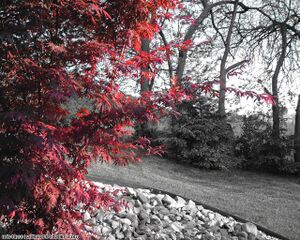 | Japanese Maple by Anonymous |
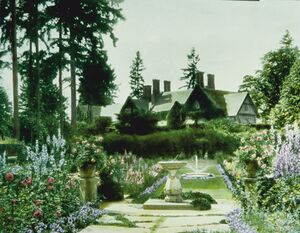 | Garden painting by Anonymous |
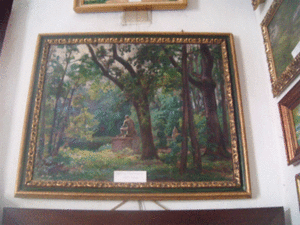 | Painting by Anonymous |
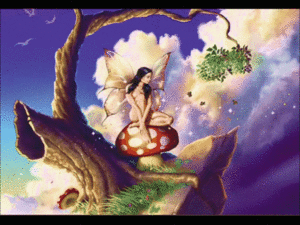 | Lucy the Fairy by StingrayZ |
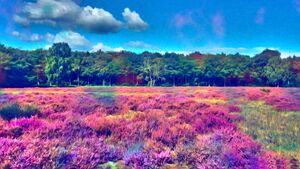 | Field by Anonymous |
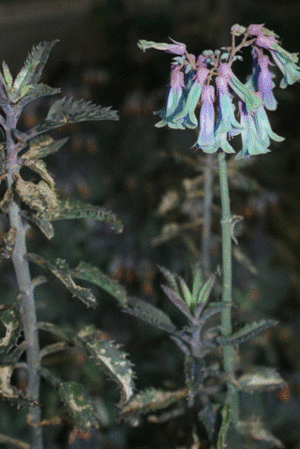 | Flowers by Chelsea Morgan |
Depth perception distortions
Depth perception distortions are defined as alterations in how a person perceives the distance of various objects within their visual field.[14] During this state, the various layers of scenery can become exaggerated, skewed, or completely rearranged.[1][15][16][17] An example of this could be the swapping of layers in a given environment, in which objects in the background begin to appear as if they are in the foreground and objects in the foreground appear as if they are in the background. In other instances, the same distortion is applied to the entire visual field, such as everything appearing small and distant or large and near.
Another example of these distortions is the complete loss of depth perception.[15][18] This occurs when the different sections of a scene appear to unify into a flat 2-dimensional image regardless of their actual distance from each other and the observer.
Depth perception distortions are often accompanied by other coinciding effects such as perspective distortions and drifting. They are most commonly induced under the influence of moderate dosages of psychedelic compounds, such as LSD, psilocybin, and mescaline.
Diffraction
Diffraction is defined as the experience of seeing rainbows and spectrums of colour embedded within the brighter parts of a person's visual field. This visual effect is likely due to pupil dilation resulting in some light sources hitting the lens of the eye in a manner which appears to spread into a larger range of the spectrum rather than a consolidated wavelength.[citation needed]
Diffraction is most commonly induced under the influence of mild dosages of psychedelic compounds, such as LSD, psilocybin, and mescaline. However, this effect is also experienced during everyday sober living for certain people.
Image examples
| Caption | |
|---|---|
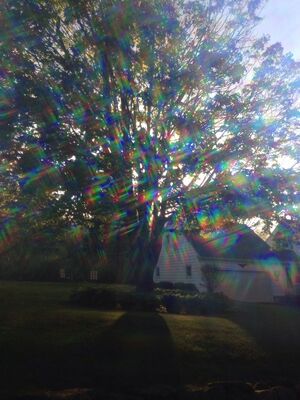 | Diffraction Shades by capture-life-with-lens.tumblr.com |
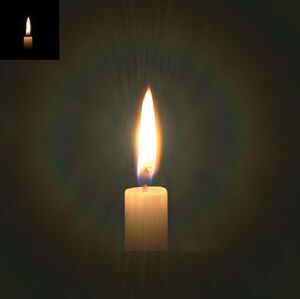 | Glare by Anonymous |
Drifting
Drifting is defined as the experience of the texture, shape, and general structure of objects and scenery appearing progressively warped, melted, and morphed across themselves.[19][1][20] These alterations gradually increase in intensity as a person stares, but are temporary and will reset to their normal appearance the moment a person double takes.
This effect is capable of manifesting itself across the 4 different levels of intensity described below:
- Peripheral - At the lowest level, visual drifting can be described as a wiggling of straight lines within the external environment. This occurs exclusively within a person's peripheral vision and cannot be directly looked at.
- Direct - At this level, visual drifting does not necessarily increase in intensity, but can now be directly looked at within a person's central line of sight. This partially alters the appearance and form of shapes, objects, and sceneries within the external environment, causing them to subtly drift, bend, and morph.
- Distinct - At this level, visual drifting becomes powerful enough to drastically alter and transform the shape of specific objects within a person's external environment. If one stares at a fixed point and keeps their eyes relatively motionless, the effect can be powerful enough to render objects progressively unrecognizable from their original form.
- All-encompassing - At the highest level of visual drifting, the intensity becomes powerful enough to distort not just specific objects, but every single point of a person's vision and the entirety of the external environment. This creates the appearance of an extremely smudged, warped, and blended mass of unrecognisable visual data.
Drifting is often accompanied by other coinciding effects such as symmetrical texture repetition and tracers.[19][4] It is most commonly induced under the influence of moderate dosages of psychedelic compounds, such as LSD, psilocybin, and mescaline. However, it can also occur to a lesser extent under the influence of certain stimulants and dissociatives such as MDMA or 3-MeO-PCP.
The particular style of this visual effect depends on the specific continuously changing direction, speed, and rhythm of the distortion. This results in a small variety of different manifestations which are defined and listed below:
Morphing
Morphing can be described as a style of visual drifting which is completely disorganised and spontaneous in both its rhythm and direction. It results in objects and scenery appearing to change gradually, morph, and warp in their size, shape, and configuration.
Breathing
Breathing can be described as a style of visual drifting which results in objects and scenery appearing to steadily contract inwards and expand outwards in a consistent rhythm, similar to the lungs of a living organism.
Melting
Melting can be described as a style of visual drifting which results in the texture of objects and scenery appearing to completely or partially melt. It begins at lower intensities as a gradual distortion of an object's texture which causes them to subtly droop, wobble, and lose their structural integrity. This gradually increases until it becomes impossible to ignore as the lines, textures, and colour between solid objects melt into one another in an extremely fluid style.
Flowing
Flowing can be described as a style of visual drifting which seems to occur almost exclusively on textures (particularly if they are highly detailed, complex, or rough in appearance). It results in the textures appearing to flow like a river in a seamless, looped animation. It is particularly common on wood grain or the fur of animals.
Image examples
| Caption | |
|---|---|
 | Mobile phone by Chelsea Morgan |
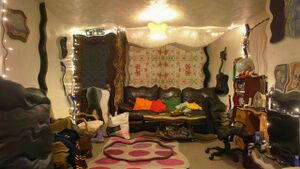 | Living room by Chelsea Morgan |
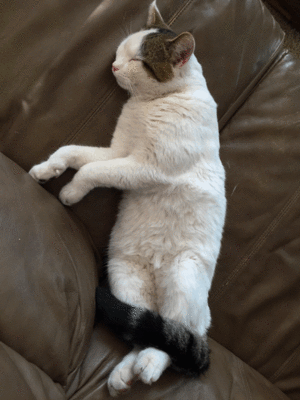 | Drifting Cat by Anonymous |
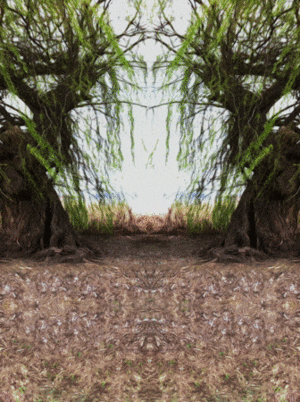 | Symmetric drifting patterns by Anonymous |
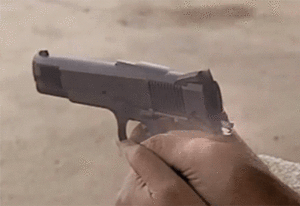 | Drifting gun by Anonymous |
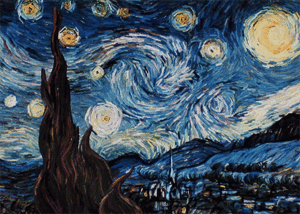 | The Starry Night by Vincent Van Gogh |
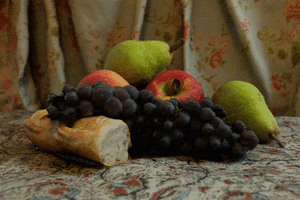 | Flowing fruit by Anonymous |
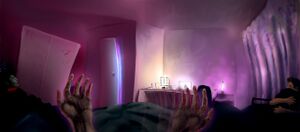 | Visual drifting by Anonymous |
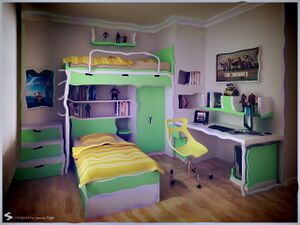 | Drifting by Anonymous |
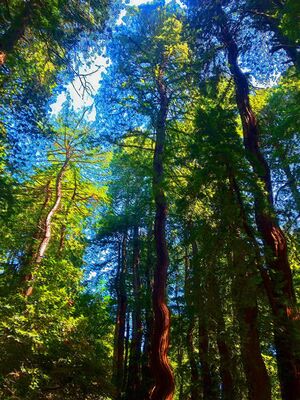 | Redwoods by CountRoloff |
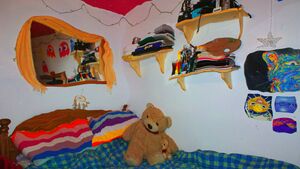 | Wibbly Wobbly Bedroom by Chelsea Morgan |
 | Lucy the Fairy by StingrayZ |
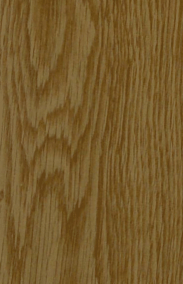 | Breathing wooden post by Chelsea Morgan |
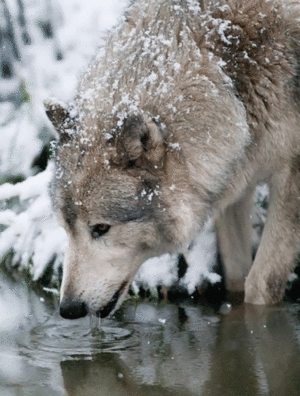 | White Wolf Drinking Water by Anonymous |
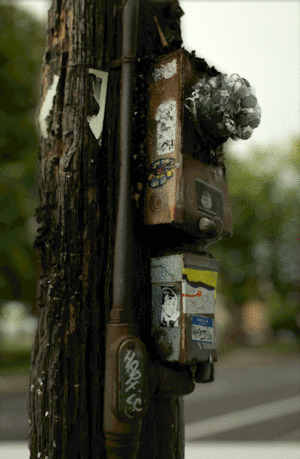 | Breathing wooden post by Anonymous |
Variations
The specific differences between each potential style of drifting can be broken down into the following variations and may occur independent of effect intensity:
- Intricate vs. Simplistic – Drifting can alter the external environment in a way that spreads out in many different complex directions and results in the original piece of sensory input becoming completely unrecognisable in appearance. Alternately, it can be simplistic in nature consisting of simple warping, wiggling and bending even at high dosages of psychoactive substances.
- Slow vs. Fast – Drifting can manifest as alterations that progress at a sudden rate and produce fast movement in the visual field or it can manifest gradually and move slowly as a person stares into it.
- Smooth vs. Jittery – Drifting can manifest as a smooth, fluid, and seamless movement or it can manifest as jittery with an extremely slow frame rate that moves in sudden and partial transitions.
- Static vs. Fleeting – Drifting can either freeze in its distorted position until one performs a double take or can be extremely fleeting in nature, resetting almost as soon as a person tries to look directly at it.
- Realistic vs. Unrealistic – Drifting can either look convincingly natural and life-like in its appearance and motion or can look extremely cartoon-like, exaggerated and unrealistic.
Environmental cubism
Environmental cubism is defined as a visual segmentation of the external environment into squares and cubes of varying amounts and sizes.[21] Once established, these segments can begin to slowly drift away from their original location and often change in size, leading to gaps in-between them. The space within these gaps can either be completely dark or composed of tightly bound visual geometry. It is worth noting that this effect is remarkably similar in its appearance to cubist photography and artwork.
This dark space can eventually grow, progressively decreasing the size of the cubes until a person finds themselves surrounded by a dissociative hole. It is not uncommon to be able to innately feel and detect the details and layout of both the different sections of the distortion and the gaps between them.
Environmental cubism is often accompanied by other coinciding effects such as environmental orbism and visual disconnection. It is most commonly induced under the influence of heavy dosages of dissociative compounds, such as ketamine, PCP, and DXM.
Image examples
| Caption | |
|---|---|
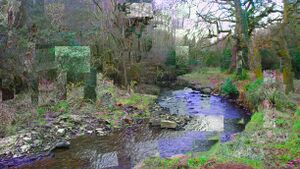 | Cubism woods by Chelsea Morgan |
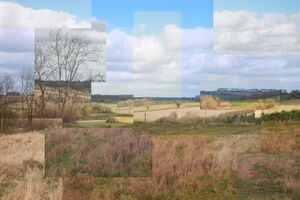 | Cubism Field by Chelsea Morgan |
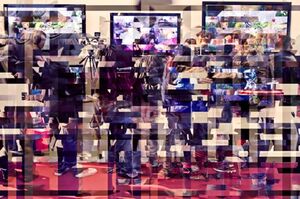 | Chrono Cubist by Diego Kuffer |
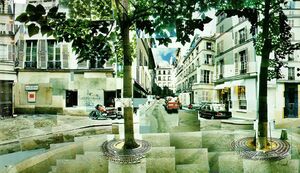 | Photo montage by David Hockney |
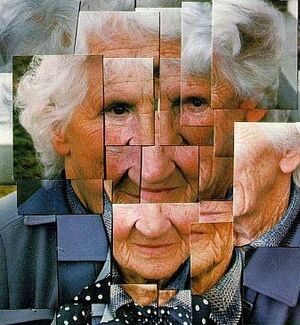 | Hockneys Mother by David Hockney |
Environmental patterning
Environmental patterning is defined as the experience of certain textures or objects such as carpets, clouds, and dense vegetation drifting into increasingly complex geometric patterns that are always clearly comprised of the original material which they are manifesting from. These structures tend to be primarily symmetrical in nature, but also include form constants, fractals, and disorganised geometric patterns.
Environmental patterning is often accompanied by other coinciding effects such as symmetrical texture repetition, geometry, and drifting. It is most commonly induced under the influence of moderate dosages of psychedelic compounds, such as LSD, psilocybin, and mescaline.
Environmental orbism
Environmental orbism is defined as a visual segmentation of the external environment into circles and spheres of varying amounts and sizes. Once established, these segments can begin to slowly drift away from their original location and often change in size, leading to gaps in-between them. The space within these gaps can be either completely dark or composed of tightly bound visual geometry.
This dark space can eventually grow, progressively decreasing the size of the orbs until a person finds themselves surrounded by a dissociative hole. It is not uncommon to be able to innately feel and detect the details and layout of both the different sections of the distortion and the gaps between them.
Environmental orbism is often accompanied by other coinciding effects such as scenery slicing and visual disconnection. It is most commonly induced under the influence of moderate dosages of dissociative compounds, such as ketamine, PCP, and DXM.
Image examples
| Caption | |
|---|---|
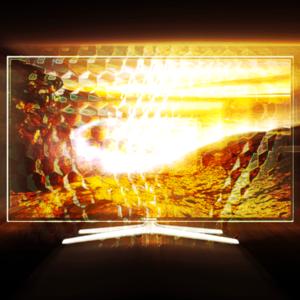 | Fly Vision by Perry |
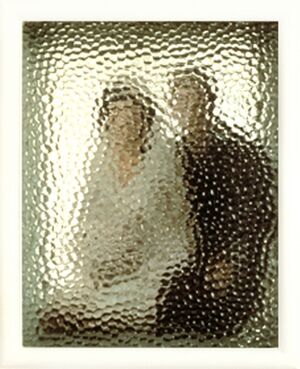 | Coloured Dreams by Bonnie rychlak |
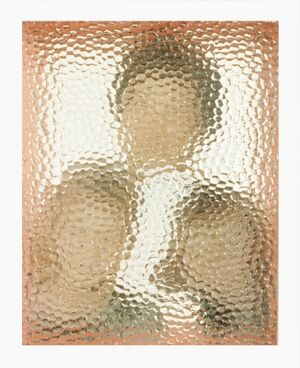 | Tiresome Threesome by Bonnie rychlak |
| Galatea of the Spheres by Salvador Dalí |
Object alterations
An object alteration is defined as the experience of perceiving an object, objects, or entire scenes progressively warp, move, stretch, shift, or otherwise animate in three-dimensional space in a manner which can vary from subtle to extreme.[1][22][23][24] When the person looks away or double-takes, the object is instantly reset to its original form. If the object is stared at directly again, it may begin to distort in a similar or different manner as before. The alterations do not occur in a uniform manner and cannot be reliably predicted. The intensity of the effect is often linked to the intensity and progression of the mental state that coincides with this effect.
For example, staring at an object such as a chair may cause its 3-dimensional shape to begin to drastically elongate or tilt into an exaggerated form which retains its original colours and textures.
This effect also commonly manifests as the perception of textures progressively stretching and projecting outward from the surfaces which they reside upon in the form of a detailed 3-dimensional structure[24] somewhat similar to complex, opaque, and solidified smoke. These structures usually maintain a size which is consistent with the width of the texture it is extending from. The textures may appear to project outwards in 3-D space anywhere between several inches to several meters in length. For example, if one stares at a painting on the wall it may extend in one direction on a 2-dimensional plane until the observer looks away.
Although this subjective effect component is categorised as a visual distortion,[24][25][26] it is likely an indirect result of external hallucinations being applied to objects within the user's environment occurring in a manner which does not introduce new data, but simply alters the perception of a 3-dimensional structure's content.
Object alterations are often accompanied by other coinciding effects such as delirium and psychosis.[26] They are most commonly induced under the influence of heavy dosages of deliriant compounds, such as DPH and datura. However, they can also occur under the influence of stimulant psychosis and sleep deprivation.
Perspective distortions
A perspective distortion is defined as a subtle to extreme change in how a person perceives the size and distance attributed their body, to specific parts of the external environment, or to the external environment as a whole.[27]
This effect is capable of manifesting itself in 4 different ways which may reflect the failure of each respective responsible visual function.[28]
- Size distortions:
When affecting distance, perspective distortions can make things seem as if they are physically closer or further away than they usually would be. This can range from a subtle experience, such as the other side of the room feeling marginally further away than it usually would be, to an extreme experience, such as feeling as if the horizon is right in front of you.
When affecting size, perspective distortions can make things seem as if they are physically smaller or larger in terms of the sense of size that one would usually attribute to them.[2][33][34] This can range from a subtle experience, such as the room feeling marginally smaller and more cramped than it usually would be, to an extreme experience, such as feeling as if the room is hundreds of miles wide.
Perspective distortions are often accompanied by other coinciding effects such as depth perception distortions and visual disconnection. They are most commonly induced under the influence of moderate dosages of dissociative compounds, such as ketamine, PCP, MXE, and DXM.
Alice in Wonderland Syndrome

Alice in Wonderland Syndrome (AIWS) is characterized by macropsia, micropsia, pelopsia, teleopsia, altered perception of shape (meta-morphopsia), and time distortion.[35]
Feelings of suddenly having an impossibly giant or tiny body are also a very common manifestation of this effect. This feeling is already known by the scientific literature as “Alice in Wonderland Syndrome”, where it is seen as a temporary condition often associated with migraines, brain tumours, and the use of psychoactive drugs.[27][36] The effect can either be attributed to the body as a whole or specific parts of it. For example, feelings of having a huge head or tiny limbs are possible.
Recursion
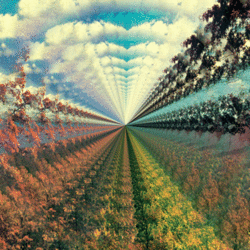
Recursion is defined as a visual distortion which partially to completely alters the appearance of one's external environment by repeating specific sections of itself across itself in a self-similar fashion. It results in the appearance of fractal-like patterns which often zoom into or away from the original image. This effect typically occurs spontaneously and rarely sustains itself for more than several seconds.
Recursion is most commonly induced under the influence of moderate dosages of psychedelic compounds, such as LSD, psilocybin, and mescaline.
Image examples
| Caption | |
|---|---|
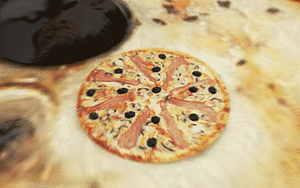 | Recursion by Tumblr |
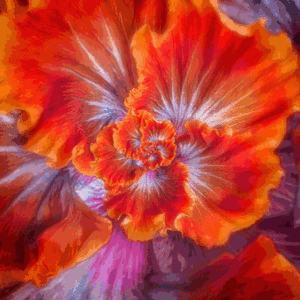 | Recursion by Giphy |
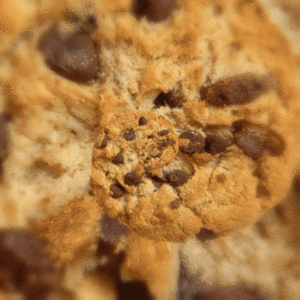 | Recursion by Giphy |
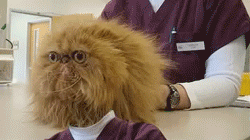 | Recursion by GifBin |
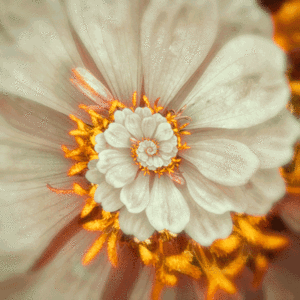 | Recursion by Giphy |
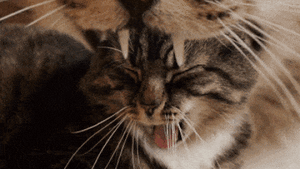 | Recursion by PandaWhale.com |
Scenery slicing
Scenery slicing is defined as the experience of a person's visual field appearing to split into separate cleanly cut sections, these individual slices then proceed to drift slowly away from their original position before disappearing and resetting to normalcy. This effect typically occurs spontaneously and rarely sustains itself for more than several seconds.
The organisation of these slices can be quite varied; they can be as simple as three separate sections or extremely complex, with formations such as multiple intricate slices of moving interlocking spirals or an infinite variety of other potential geometric designs.
Scenery slicing is often accompanied by other coinciding effects such as environmental cubism and visual disconnection. It is most commonly induced under the influence of moderate dosages of dissociative compounds, such as ketamine, PCP, and DXM. However, it can also occur to a lesser extent under the influence of psychedelics[4] such as LSD, psilocybin, and mescaline.
Image examples
| Caption | |
|---|---|
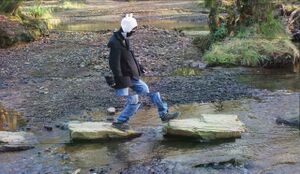 | Finn Jumping Rocks by Chelsea Morgan |
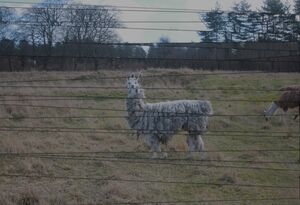 | Llama by Chelsea Morgan |
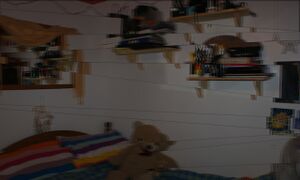 | Dissociative scenery slicing by Chelsea Morgan |
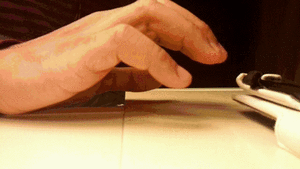 | Scenery Slicing by Subsentience |
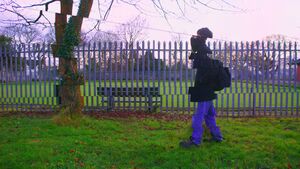 | A Walk in the Park by Chelsea Morgan |
Symmetrical texture repetition
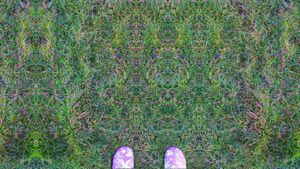
Symmetrical texture repetition is defined as the perception of textures becoming mirrored repeatedly over their own surface in an intricate and symmetrical fashion that is consistent across itself. This maintains the same level of detail no matter how closely one attempts to look at the distortion and tends to remain most prominent within one's peripheral vision. It usually manifests itself in rough textures such as grass, carpets, tree bark, and asphalt.
During this state, if one stares at a fixed point the symmetrical texture repetition may progressively increase and further tesselate into more complex forms. However, this progression of complexity will usually reset back to baseline as soon as one double takes.
Symmetrical texture repetition is often accompanied by other coinciding effects such as pattern recognition enhancement[4][19] and transformations in a manner which can result in the appearance of a huge array of abstract forms and imagery embedded within the symmetry. It is most commonly induced under the influence of mild dosages of psychedelic compounds, such as LSD, psilocybin, and mescaline. However, it can also occur less commonly under the influence of certain stimulants and dissociatives, such as MDMA or 3-MeO-PCP.
Tracers
Tracers are defined as the experience of trails of varying lengths and opacity being left behind moving objects in a manner that is similar to those found in long exposure photography.[7] These can manifest as exactly the same colour of the moving object which is producing it or can sometimes be a randomly selected colour of their own.
A relatively consistent way to reproduce this visual effect is to simply move one's hand in front of their face or throw an object under the influence of a moderate dose of psychedelics.
This effect is capable of manifesting itself across the 4 different levels of intensity described below:
- Subtle - At the lowest level, tracers can be described as an almost completely transparent after image which disappears quickly and drags closely behind moving objects.
- Distinct - At this level, tracers increase in length to become roughly half as long as the distance across the visual field which the object it is following has travelled. The clarity of these tracers shifts from barely visible to distinct and partially transparent in colour.
- Intense - At this level, tracers become mostly solid in appearance and almost completely opaque with increasingly distinct and sharp edges. This creates a clear contrast between the tracer itself and the background behind it. The tracers become slower to fade from a person's vision and can remain in the air for up to several seconds. This results in longer trails covering the entire distance across the visual field which the object creating it has moved.
- All-encompassing - At the highest level, a person’s visual field has become so sensitive to the creation of tracers that it entirely smudges and blurs into an all-encompassing tracer at the slightest movement of an object or the eye. This can make it extremely difficult to see unless one's eyes are kept still in a motionless environment as tracers linger almost indefinitely or until one looks elsewhere within their visual field.
Tracers are often accompanied by other coinciding effects such as drifting and after images. They are most commonly induced under the influence of mild dosages of psychedelic[37][38] compounds, such as LSD[2][5][9][39], psilocybin, and mescaline. However, they can also occur less commonly under the influence of certain stimulants and dissociatives such as MDMA or 3-MeO-PCP.
Image examples
| Caption | |
|---|---|
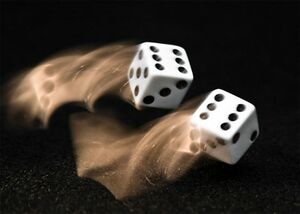 | Tumbling Dice by Rosendahl |
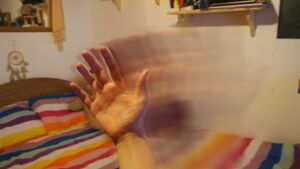 | Tracers by Chelsea Morgan and ohwatever |
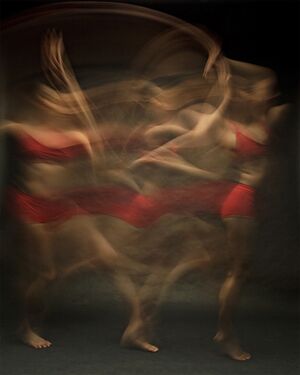 | Motion by Bill Wadman |
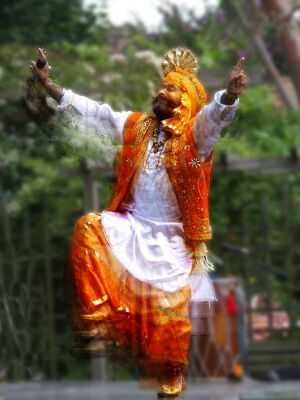 | Shamanic tracers by Anonymous |
Visual flipping
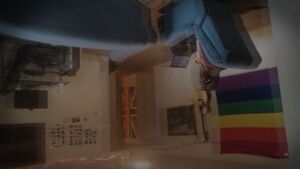
Visual flipping is defined as a distortion in the surrounding environment that makes it appear as if it has been rotated, mirrored, or flipped into an alternative orientation. For example, during this experience, one's vision may suddenly be viewed as upside down or sideways. This effect is usually very fleeting in its occurrence, typically ranging from a few seconds to less than a minute.
Visual flipping is an uncommon and rare effect which is often accompanied by other coinciding effects such as visual stretching, double vision, and visual disconnection. It is most commonly induced under the influence of heavy dosages of dissociative compounds, such as ketamine, PCP, and DXM. However, this holds particularly true for the onset of nitrous oxide and salvia divinorum, especially in the moments immediately preceding ego death.
Visual haze
Visual haze is defined as a distortion in the surrounding environment that makes it appear as if the air is shrouded in an imaginary cloud of smoke, fog, or haze. This effect varies in its intensity, ranging from subtle and barely visible to extreme and all-encompassing in a manner which can significantly impair a person's vision.
Visual haze is often accompanied by other coinciding effects such as visual acuity suppression and external hallucinations. It is most commonly induced under the influence of mild dosages of hallucinogenic compounds such as psychedelics, deliriants, and cannabinoids. However, it can also occur less commonly under the influence of stimulant psychosis and sleep deprivation.
Visual stretching
Visual stretching is defined as a distortion in a person's field of view that makes it appear as if it is horizontally or vertically stretching in its size. This effect varies in its intensity, ranging from subtle and barely visible to extreme and all-encompassing in a manner which can completely impair a person's sense of sight. At higher levels, it can stretch a person's vision into a seemingly infinite length, which typically renders their field of view as a thin strip of sensory data surrounded on either side by either empty space or subtle geometry.
Visual stretching is most commonly induced under the influence of heavy dosages of sudden onset hallucinogenic compounds, such as nitrous oxide, DMT, and salvia divinorum. This holds particularly true in the moments immediately preceding ego death.
See also
References
- ↑ 1.0 1.1 1.2 1.3 1.4 1.5 1.6 Kleinman, J. E.; Gillin, J. C.; Wyatt, R. J. (1977). "A Comparison of the Phenomenology of Hallucinogens and Schizophrenia From Some Autobiographical Accounts*". Schizophrenia Bulletin. 3 (4): 560–586. doi:10.1093/schbul/3.4.560. ISSN 0586-7614.
- ↑ 2.0 2.1 2.2 2.3 Abraham, Henry David (1983). "Visual Phenomenology of the LSD Flashback". Archives of General Psychiatry. 40 (8): 884. doi:10.1001/archpsyc.1983.01790070074009. ISSN 0003-990X.
- ↑ Bender, Morris B.; Feldman, Martin; Sobin, Allan J. (1968). "PALINOPSIA". Brain. 91 (2): 321–338. doi:10.1093/brain/91.2.321. ISSN 0006-8950.
- ↑ 4.0 4.1 4.2 4.3 4.4 Papoutsis, Ioannis; Nikolaou, Panagiota; Stefanidou, Maria; Spiliopoulou, Chara; Athanaselis, Sotiris (2014). "25B-NBOMe and its precursor 2C-B: modern trends and hidden dangers". Forensic Toxicology. 33 (1): 1–11. doi:10.1007/s11419-014-0242-9. ISSN 1860-8965.
- ↑ 5.0 5.1 5.2 5.3 Abraham, Henry D.; Wolf, Ernst (1988). "Visual function in past users of LSD: Psychophysical findings". Journal of Abnormal Psychology. 97 (4): 443–447. doi:10.1037/0021-843X.97.4.443. ISSN 1939-1846.
- ↑ Kawasaki, Aki (1996). "Persistent Palinopsia Following Ingestion of Lysergic Acid Diethylamide (LSD)". Archives of Ophthalmology. 114 (1): 47. doi:10.1001/archopht.1996.01100130045007. ISSN 0003-9950.
- ↑ 7.0 7.1 7.2 Dubois, Julien; VanRullen, Rufin (2011). "Visual Trails: Do the Doors of Perception Open Periodically?". PLoS Biology. 9 (5): e1001056. doi:10.1371/journal.pbio.1001056. ISSN 1545-7885.
- ↑ Ermentrout B. The excited cortex - LSD trails, phosphenes, and other visual confections. 1999. 201 Eighth Annual Computational Neuroscience Meeting; Pittsburgh, Pennsylvania; July 1999. Abstracts.
- ↑ 9.0 9.1 Asher, Harvey (1971). ""Trailing" Phenomenon—A Long-Lasting LSD Side Effect". American Journal of Psychiatry. 127 (9): 1233–1234. doi:10.1176/ajp.127.9.1233. ISSN 0002-953X.
- ↑ Schwartz, K. (1997). "Nefazodone and visual side effects". American Journal of Psychiatry. 154 (7): 1038a–11038. doi:10.1176/ajp.154.7.1038a.
- ↑ Lauterbach, E.; Abdelhamid, A.; Annandale, J. (2000). "Posthallucinogen-Like Visual Illusions (Palinopsia) with Risperidone in a Patient without Previous Hallucinogen Exposure: Possible Relation to Serotonin 5HT2a Receptor Blockade". Pharmacopsychiatry. 33 (01): 38–41. doi:10.1055/s-2000-8452. ISSN 0176-3679.
- ↑ 12.0 12.1 Fischer, R.; Hill, R. M.; Warshay, Diana (1969). "Effects of the psychodysleptic drug psilocybin on visual perception. Changes in brightness preference". Experientia. 25 (2): 166–169. doi:10.1007/BF01899102. ISSN 0014-4754.
- ↑ Baggott, M.J.; Coyle, J.R.; Erowid, E.; Erowid, F.; Robertson, L.C. (2011). "Abnormal visual experiences in individuals with histories of hallucinogen use: A web-based questionnaire". Drug and Alcohol Dependence. 114 (1): 61–67. doi:10.1016/j.drugalcdep.2010.09.006. ISSN 0376-8716.
- ↑ Fischer, Roland; Hill, Richard; Thatcher, Karen; Scheib, James (1970). "Psilocybin-induced contraction of nearby visual space". Agents and Actions. 1 (4): 190–197. doi:10.1007/BF01965761. ISSN 0065-4299.
- ↑ 15.0 15.1 Marsh, A. (1979). "Visual Hallucinations During Hallucinogenic Experience and Schizophrenia". Schizophrenia Bulletin. 5 (4): 627–630. doi:10.1093/schbul/5.4.627. ISSN 0586-7614.
- ↑ Szara, S. The comparison of the psychotic effect of tryptamine derivatives with the effects of mescaline and LSD-25 in self-experiments. In: Garattini, S., and Ghetti, V., eds. Psychotropic Drugs. Amsterdam: Elsevier Publishing Company, 1957. pp. 460-467. https://www.erowid.org/references/texts/show/1667docid1552
- ↑ Hofmann, A. Psychotomimetic drugs, chemical and pharmacological aspects. Acta Physiologica Pharmacologica Neerlandica, 8:240-258, 1959. http://www.samorini.it/doc1/alt_aut/ek/hofmann-psychotomimetic-drugs.pdf
- ↑ Sechehaye, Marguerite; Rubin-Rabson, Grace (1951). "Autobiography of a schizophrenic girl: Reality lost and gained, with analytic interpretation". doi:10.1037/11511-000.
- ↑ 19.0 19.1 19.2 Bersani, Francesco Saverio; Corazza, Ornella; Albano, Gabriella; Valeriani, Giuseppe; Santacroce, Rita; Bolzan Mariotti Posocco, Flaminia; Cinosi, Eduardo; Simonato, Pierluigi; Martinotti, Giovanni; Bersani, Giuseppe; Schifano, Fabrizio (2014). "25C-NBOMe: Preliminary Data on Pharmacology, Psychoactive Effects, and Toxicity of a New Potent and Dangerous Hallucinogenic Drug". BioMed Research International. 2014: 1–6. doi:10.1155/2014/734749. ISSN 2314-6133.
- ↑ Muthukumaraswamy, S. D.; Carhart-Harris, R. L.; Moran, R. J.; Brookes, M. J.; Williams, T. M.; Errtizoe, D.; Sessa, B.; Papadopoulos, A.; Bolstridge, M.; Singh, K. D.; Feilding, A.; Friston, K. J.; Nutt, D. J. (2013). "Broadband Cortical Desynchronization Underlies the Human Psychedelic State". Journal of Neuroscience. 33 (38): 15171–15183. doi:10.1523/JNEUROSCI.2063-13.2013. ISSN 0270-6474.
- ↑ Huxley, A. (1954). The Doors of Perception. p. 22. ISBN 9781907590092.
- ↑ Obreshkova, D., Kandilarov, I., Angelova, V. T., Iliev, Y., Atanasov, P., & Fotev, P. S. (2017). PHARMACO-TOXICOLOGICAL ASPECTS AND ANALYSIS OF PHENYLALKYLAMINE AND INDOLYLALKYLAMINE HALLUCINOGENS (REVIEW). PHARMACIA, 64(1), 41-42. http://bsphs.org/wp-content/uploads/2017/04/Angelova.pdf
- ↑ Gallimore, Andrew R. (2015). "Restructuring consciousness â€"the psychedelic state in light of integrated information theory". Frontiers in Human Neuroscience. 9. doi:10.3389/fnhum.2015.00346. ISSN 1662-5161.
- ↑ 24.0 24.1 24.2 Juszczak, Grzegorz R.; Swiergiel, Artur H. (2013). "Recreational Use of D-Lysergamide from the Seeds ofArgyreia Nervosa,Ipomoea Tricolor, Ipomoea Violacea,andIpomoea Purpureain Poland". Journal of Psychoactive Drugs. 45 (1): 79–93. doi:10.1080/02791072.2013.763570. ISSN 0279-1072.
- ↑ Espiard, M; Lecardeur, L; Abadie, P; Halbecq, I; Dollfus, S (2005). "Hallucinogen persisting perception disorder after psilocybin consumption: a case study". European Psychiatry. 20 (5-6): 458–460. doi:10.1016/j.eurpsy.2005.04.008. ISSN 0924-9338.
- ↑ 27.0 27.1 G Lerner, A., Lev-Ran, S. (2015). "LSD-associated "Alice in Wonderland Syndrome"(AIWS): A Hallucinogen Persisting Perception Disorder (HPPD) Case Report". The Israel Journal of Psychiatry and Related Sciences. 52 (1): 67–68. ISSN 2617-2402.
- ↑ Schneck, Jerome M. (1965). "MACROPSIA". American Journal of Psychiatry. 121 (11): 1123–1124. doi:10.1176/ajp.121.11.1123. ISSN 0002-953X.
- ↑ "macropsia". APA Dictionary of Psychology. Retrieved 20 May 2022.
- ↑ "micropsia". APA Dictionary of Psychology. Retrieved 20 May 2022.
- ↑ "pelopsia". Medical Dictionary. Retrieved 20 May 2022.
- ↑ "teleopsia". APA Dictionary of Psychology. Retrieved 20 May 2022.
- ↑ Horowitz, Mardi J. (1969). "Flashbacks: Recurrent Intrusive Images After the Use of LSD". American Journal of Psychiatry. 126 (4): 565–569. doi:10.1176/ajp.126.4.565. ISSN 0002-953X.
- ↑ Hamilton M (ed): Fish's Clinical Psychopathology. Baltimore, Williams & Wilkins Co, 1974. https://books.google.com/books?hl=en&lr=&id=gHdQTZNkA9YC&oi=fnd&pg=PA1&dq=Hamilton+M+(ed):+Fish%27s+Clinical+Psychopathology.&ots=okWOwjZJfq&sig=Y85lNwTChlGIhtdhohkn-MXSyCA#v=onepage&q=Hamilton%20M%20(ed)%3A%20Fish's%20Clinical%20Psychopathology.&f=false
- ↑ Cau, C (October 1999). "[The Alice in Wonderland syndrome]". Minerva medica. 90 (10): 397–401. PMID 10767914.
- ↑ Blom, Jan Dirk (2016). "Alice in Wonderland syndrome". Neurology: Clinical Practice. 6 (3): 259–270. doi:10.1212/CPJ.0000000000000251. ISSN 2163-0402.
- ↑ Abraham, H. D., Mccann, U. D., Ricaurte, G. A. (2002), "Psychedelic Drugs", CiteSeerX
- ↑ O'Malley, John E. (1972). "Trifluoperazine for The "Trailing" Phenomenon". JAMA: The Journal of the American Medical Association. 220 (9): 1244. doi:10.1001/jama.1972.03200090066017. ISSN 0098-7484.
- ↑ Schwartz, K. (1997). "Nefazodone and visual side effects". American Journal of Psychiatry. 154 (7): 1038a–11038. doi:10.1176/ajp.154.7.1038a.